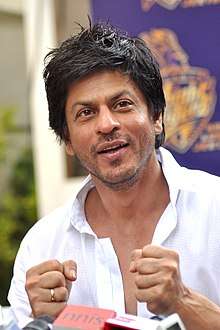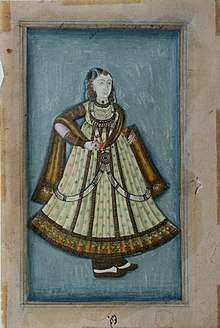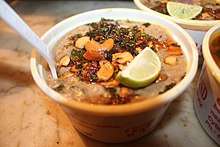Hyderabadi Muslims
| Urdu: حیدرآبادی مسلمان, translit. (Hyderābādi Musalmān) | |
|---|---|
| |
| Total population | |
|
925,929 (1881)[1] Present Worldwide Figures Unknown, but about 1.71 million in Hyderabad district[2] | |
| Regions with significant populations | |
|
| |
| Languages | |
| Urdu in the forms of Hyderabadi Urdu and the Dakhini sub-dialect as well as standard Urdu• Hindi • Telugu • Marathi• Kannada• Sindhi • English • The vernacular languages of other countries in the diaspora | |
| Religion | |
| • Minority Shia and Isma'ilism | |
| Related ethnic groups | |
| • Other Indian Muslim communities • Telugu people • Andhra Muslims • Marathi Muslims • Dakhini Muslims • Muhajir people |
Hyderabadi Muslims are an ethnoreligious community of Dakhini Urdu-speaking Muslims, part of a larger group of Dakhini Muslims, from the area that used to be the princely state of Hyderabad, India, including cities like Hyderabad, Aurangabad, Latur, Gulbarga and Bidar.
While the term "Hyderabadi" now only refers to residents in and around the city of Hyderabad, the term Hyderabadi Muslims can refer to those native Muslim residents of the erstwhile princely state. The native language of the Hyderabadi Muslims is Hyderabadi Urdu, which is a form of the Dakhini language.
With their origins in the Muslim Bahmani Sultanate and then the Deccan sultanates, Hyderabadi Muslim culture became defined in the latter half of the reign of the Asif Jahi Dynasty in Hyderabad. The culture exists today mainly in the old city of Hyderabad, Aurangabad, Bidar and among the Hyderabadi Muslim diaspora around the world, in particular, Pakistan,[3] the Arab states of the Persian Gulf, USA, Canada and the United Kingdom.[4]
History
The Deccan plateau acted as a bulwark sheltering South India from the invasions and political turmoil that affected North India. This allowed the Muslim-ruled state of Hyderabad to develop a distinctive culture during the Qutb Shahi dynasty, brief Mughal rule and later the Asaf Jahi dynasty of the Nizams.
According to Time, the seventh Nizam was the richest man in the world during the late 1940's, and fifth richest person of all time according to Forbes Magazine after adjustment for inflation and currency purchasing power parity.[5]
The Nizam was the Muslim ruler of the vast princely Hyderabad State. The capital city of Hyderabad was primarily Urdu-speaking Muslim until the Incorporation of Hyderabad into India and the subsequent rise to dominance of Telugu-speaking people of Telangana State. The state's economy was agrarian, and Hyderabad was primarily a government and administrative hub, run mostly (but far from exclusively) by Muslims. The aristocracy, jagirdars and deshmukhs (wealthy landowners), and even minor government officials, could afford to hire servants, usually also Muslims, in a social order similar to the class system of Victorian England. The Nizam allied himself with the British early on, with ensuing political stability. The Muslim upper and middle classes were free to concentrate on a care-free and leisurely lifestyle involving clothes, jewelry, food, music, literary arts, and other indulgences, little of which trickled down to the servant class, known as naukar (a word originally used for the Mughal Emperor Babur's closest feudal retainers).
After the fall of the Mughal Empire in 1857, many Muslim writers, poets, scholars, musicians and other eminent personalities migrated from Delhi to Hyderabad in hope of seeking patronage of the Nizam or the nobility. Muslims continued to emigrate to the state seeking employment in the Nizam's court, army, Hyderabad Civil Service or educational institutions. Among those who spent significant time in Hyderabad are writers Dagh Dehlvi, Fani Badayuni, Josh Malihabadi, Ali Haider Tabatabai, religious scholar Shilbi Nomani and classical musicians Tanrus Khan and Bade Ghulam Ali Khan.
After Indian Independence from the British Raj, Hyderabad State, under the rule of the seventh Nizam lasted for a year, until September 18, 1948, when the Indian Army launched Operation Polo, and invaded Hyderabad state, annexing it into the Indian Union. The Invasion resulted in the massacre of thousands of Hyderabadi Muslims, and mass migration mainly to the west, and Pakistan.[6][7][8]
Hyderabadi Muslim Identity after Integration
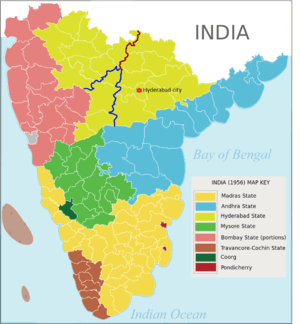
The Integration of Hyderabad, into the dominion of India, other than the shock of the controversial massacre of the integration,[9][10] took a turn of an identity crisis for the Hyderabadi Muslim people.[11] Thousands of Hyderabadi Muslims emigrated from the newly integrated Indian state of Hyderabad to Pakistan, the UK, the U.S. and Canada, resulting in a large diaspora.[12]
The people who migrated to Pakistan were now placed under a new term called Muhajir, along with other Urdu speaking immigrants from present day India. The Muhajir people began to dominate politics and business mainly in the metropolitan city of Karachi but their unique Hyderabadi Muslim Identity was lost, and has now evolved into a result of Karachi's booming cosmopolitan scene.[13] The Hyderabadi Muslims who stayed in the integrated Hyderabad state were faced with new language issues, and a wave of immigration from other Indian states, especially after 1956.[14]
After the Indian reorganization of 1956, with states being divided on linguistic lines, Hyderabadi Muslims, in Telangana, Marathwada, and Hyderabad-Karnataka were faced with the learning and emerging dominance of Telugu, Marathi, and Kannada respectively, and their native language Dakhini became a home language while Urdu in the forefront of Politics in these regions became comparatively less widespread.[15] The present day Hyderabadi Muslims know very little about their cultural heritage, especially those who aren't from Hyderabad city, or India. Hyderabadi Muslims are now seen as a result of Indian cosmopolitanism, and their history is being lost in Indian textbooks.[16]
The relative isolation of Hyderabad until annexation to India, its distinctive dialect of Urdu and the strong web of interconnecting family relationships that still characterizes Hyderabadi Muslims, sometimes leads to charges of parochialism from other Indian Muslim communities, but it also ensures a Hyderabadi Muslim identity endures among the Indian diaspora.
Demographics and distribution
The largest concentration of Hyderabadi Muslims is in the old city of Hyderabad. After the Partition of India and the Incorporation of Hyderabad by India, the Muslims of the state lost their privileged status, so significant numbers chose to migrate to other countries such as Pakistan, the Arab States of the Persian Gulf, the United States, UK, Canada and Australia.[17][18]
A section of Hyderabadi Muslims are of Hadhrami Arab origin, who came to serve in the Nizam's military. They are known as Chaush and mostly reside in the Barkas neighbourhood of Hyderabad. There are also some Siddis who are of African descent.[19][20]
In Pakistan, most of the Hyderabadi migrants are settled in the southern port city of Karachi. Estimates of the Hyderabadi population in Karachi range between 20,000 and 200,000 today.[21] The main neighbourhoods where the Hyderabadi migrants in Karachi initially settled were Hyderabad Colony, Bahadurabad and Laiqabad.[22] In 2007, a replica of the famous Charminar monument in Hyderabad was built at the main crossing of Bahadurabad.[23] Some notable Pakistani people who migrated from the former Hyderabad State include Muhammad Raziuddin Siddiqui, Syed Mohammad Ahsan, Asif Iqbal Razvi, Waheed Yar Khan, and Anwar Maqsood.
Classification

Hyderabadi Muslims today, refer to the Urdu speaking Muslim community, from the 1801 landlocked princely state of Hyderabad, who developed a distinct cultural identity from other Dakhini Muslims.[24] Even though the princely state of Hyderabad had once reached the southernmost points of India, it's the culture from the known landlocked territories of the Nizam, that constitutes Hyderabadi Muslim culture, while the Dakhini Muslims of the Carnatic, and the Circars, developed their own distinct culture, and culinary tradition.[25] The Chaush community, even though they speak Urdu, and live in the erstwhile Hyderabad State, are usually not considered Hyderabadi Muslims, since they came recently to the region. Even though they absorbed many Hyderabadi Muslim cultural features, namely language and cuisine (Chaush cuisine has more Arab influences), they're a more homogeneous group, of Hadhrami Arab ancestry, and reside in close knit Chaush communities such as the Barkas neighborhood of Hyderabad.[26][27] This is compared to most Hyderabadi Muslims, who have ancestries from various ethnic origins, and are less a homogeneous group.[28]
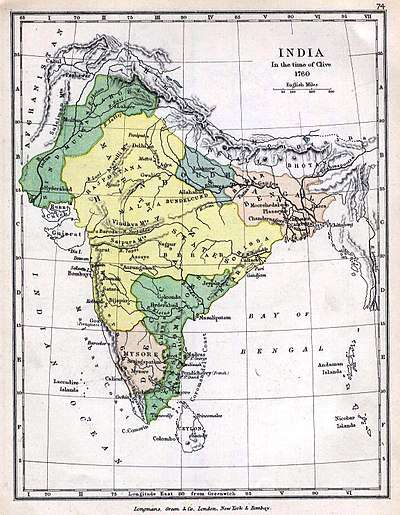
Politics
Hyderabadi Muslims have organized themselves politically along religious lines.The most prominent example of this is the All India Majlis-e-Ittehadul Muslimeen, currently led by Asaduddin Owaisi. The party dominates the politics in Hyderabad's Old City, and consistently wins seats for the Lok Sabha (Lower House of Indian Parliament) and the Telangana Legislative Assembly. The party claims to represent the interests of Muslims by campaigning for greater protection of minority rights.[29] A rival breakaway faction of the AIMIM is the Majlis Bachao Tehreek that also claims to represent the interests of Muslims in Hyderabad.
Hyderabadi Muslims who have been strong supporters of secular progressive movements, such as Indian freedom fighters Maulvi Allauddin, Turrebaz Khan,[30] Abid Hasan, Urdu poets Makhdoom Mohiuddin and Sulaiman Areeb, and Hassan Nasir who participated in the Telangana Rebellion against the rule of the Nizam. Hyderabadi Muslims were also at the forefront of the formation of the Comrades Association in 1939, one of the first communist organizations in Hyderabad which struggled against the Nizam. Other secular members of the community include Shoaibullah Khan, the editor of the Urdu daily Imroz that was critical of the Razakars and urged Hyderabad's integration with India (he was stabbed to death). The story of a poor Muslim peasant named Bandagi who was killed while struggling against the landlord was immortalised in the popular drama Ma Bhoomi about the Telangana Rebellion. In 1946, editor of Urdu daily Saltanat Sayyid Ahmedullah Qadri was the first journalist of Hyderabad state who wrote articles on the One nation Theory.
Culture
Hyderabadi Muslims, are noted for their hospitable nature also known as Deccani Tehzeeb. While Hyderabadi Muslims take pride in their "Nawabi" language, literature, poetry, architecture, and cuisine. The performing arts are often overlooked, especially regarding Hyderabadi culture. In fact, the culture of the Hyderabadi Muslims is being lost.[31][32] The founding of the city of Hyderabad can be attributed to one of the wives of Muhammad Quli Qutb Shah, Queen Bhagyamati, who was a dancer in the courts of the Golkonda kings, with whom the founder of Hyderabad had named the city in her honour, Bhagyanagar, and later Hyderabad. Tales of the legendary dancers Taramati, and Premamati, are also an insight into the rich culture under the Qutb Shahi era. Mah Laqa Bhai, a prominent Hyderabadi Muslim poet of the 18th century, patronized the Kathak dance form in the courts of the Nizam, which is now being lost amongst Hyderabadi Muslims.[33]
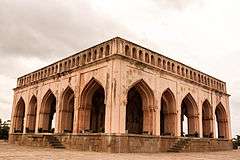
Apart from these, a traditional Hyderabadi Muslim wedding is identified by various local traditional elements, such as the traditional garb, Sherwani for the groom and Khada Dupatta along with jewelry for the bride, as well as Hyderabadi cuisine served at the ceremony.
Another cultural practice unique to the region is Tasmia Qwani also known as Bismillah Ceremony, family ceremony in which a Muslim child is initiated to read the Quran. It is also characterized by local elements.[34]
Communal Harmony, known as Ganga-Jamuni Tehzeeb, is integral to the Culture of Hyderabad.[35][36][37][38]
Other than musical forms of art, Hyderabadi Muslims have taken great honour in the writing, and reading of poetry, and annual Mushairas and Mehfils take place around the world, which has become a symbol of unity for Hyderabadi Muslims, and Urdu poets alike, continuing an ancient tradition.[39]
Language and literature

One of the most identifiable markers of Hyderabadi Muslim culture is the local dialect of Urdu, called Hyderabadi Urdu which in itself is a form of Dakhini. It is distinct by its mixture of vocabulary from Turkish, Persian and Arabic, as well in some vocabulary from Telugu and Marathi that are not found in the standard dialect of Urdu. In terms of pronunciation, the easiest way to recognize a Hyderabadi Urdu is use of "nakko"(no) and "hau"(yes); whereas in standard Urdu its "nahi" for (no) and "haa" for (yes).
Though Hyderabadi Urdu or Dakhini are the native languages of the Hyderabadi Muslim people, most people can speak standard Urdu, and often put Urdu as their mother tongue on censuses, as Dakhini is not a recognized language as such. Along with the languages they learn from birth, they can speak Hindi, which is mutually ineligible with standard Urdu, and taught in most Indian schools. Hyderabadi Muslims can also speak the majority languages spoken in the regions they live, namely Telugu, Marathi, and Kannada. The other important characteristic of the natives is cultural refinement in terms of interpersonal communication, referred to as meethi boli (sweet and civilised speech). Tameez, tehzeeb and akhlaq (etiquette, custom, and tradition) are considered very important and guests are treated well with a lot of mehmaan nawaazi (hospitality).
The Qutb Shahs were regarded as the great patrons of Urdu, Farsi and Telugu language. The region saw a growth of Deccani Urdu literature, the Deccani Masnavi and Diwan composed during those periods are among the earliest available manuscripts in the Urdu language. The literary work of this region is influenced with the regional Marathi, Telugu, and Kannada in parallel with Arabic and Persian including the adoption of poetic meters and a great quantity of renovated words.[40] The Fifth Sultan of the dynasty, Mohammed Quli Qutb Shah was himself an Urdu poet.[41]
The period of Nizams saw a growth of literary growth since after printing was introduced in Hyderabad. In 1824 AD, the first collection of Urdu Ghazals named Gulzar-e-Mahlaqa (Mahlaqa's garden of flowers) written by Mah Laqa Bai, was printed and published from Hyderabad.[42]
After the Revolt of 1857, many Urdu writers, scholars and poets who lost their patronage at Delhi made Hyderabad their home, that grew and brought reforms in the literary and poetry work. Scholars continued to migrate to Hyderabad during the reign of Asaf Jah VI and his successor Asaf Jah VII. These included Shibli Nomani, Dagh Dehlvi, Fani Badayuni, Josh Malihabadi, Ali Haider Tabatabai, Zahir Dehlvi and many others.[43][44]
The reign of Nizam VII saw many reforms in literary work. For the first time in history the Nizams introduced Urdu as a language of court, administration and education. Other notable poets, scholars and writers of the early 20th century are Amjad Hyderabadi,[45] Makhdoom Mohiuddin, Sayyid Shamsullah Qadri, Mohiuddin Qadri Zore[46] and Sulaiman Areeb. Maharaja Sir Kishen Pershad, although not a Muslim himself, was steeped in Hyderabadi Muslim Culture and wrote poetry under the pen name Shad.[47]
In 2017, Urdu was declared the second official language of the state of Telangana. (after Telugu) This move was praised by many, especially Muslims of Hyderabad who spoke Urdu as their mother tongue.[48][49]
Music
Though, the once great dance traditions among the Hyderabadi Muslims are almost lost, two distinct, cultural practices are still popular, namely Marfa, and Dholak ke Geet. Marfa was brought by the Siddi and Chaush peoples, of Africa and Yemen, who were deployed in the army of the Nizams. This music, is accompanied by the beating drums of a great tradition, which were once popular in national celebrations of the dissolved Hyderabad state, is still popular among Hyderabadi Muslims in weddings.[50] Dholak ke geet is also one such great tradition. Dholak ke geet are songs, that have been orally passed down from generation to generation since the time of the Nizams, and is sung at weddings, accompanied by a Dholak drum.[51]
Qawwali is also popular among the community,[52] and is performed regularly at dargahs such as Dargah Yousufain and Dargah Pahadi Shareef.[53][54] It used to be patronized by the Nizams as well as the nobility. The great classical musicians such as Bade Ghulam Ali Khan, Inayat Khan, Ustad Tanrus Khan, Munshi Raziuddin and Bahauddin Khan used to perform at the Nizam's court. The contemporary qawwals Ateeq Hussain Khan and the Warsi Brothers reside in Hyderabad and perform regularly in the city.
Cuisine
The native cooking style of the community is the Hyderabadi cuisine, which evolved during the Asaf Jahi period. It is heavily influenced by Mughal, Turkish, and Arab along with the influence of the native Telugu and Marathwada cuisines. It comprises a broad repertoire of rice, wheat and meat dishes and the skilled use of various spices, herbs and natural edibles.[55][56][52]
Some famous Hyderabadi cuisine (dishes) that are served at weddings are: Hyderabadi Biryani, Haleem, Khubani ka Mitha, Gil-e-Firdaus, Double Ka Meetha, Luqmi, Kaddu ki Kheer (A type of Kheer), Mirchi ka Salan and Baghare Baigan.
Other popular food items are: Chakna, Tamate ka Kut, Khatti Dal, Dalcha, Shirmal, Rawghani Roti, Nahari, Pasande, Pathar Ka Ghosht, Naan, Dum Ka Murgh, Khagina, Khichdi, Nargisi Kheema, Shaami, Kofte, Tala Hua Ghosht, Poori, Kheer, Sheer Khorma, Til ka Khatta, Til ki Chutney and Qubuli, Shikampur, Tahari, Khichdi. The Arab dishes Mandi and Shawarma are also popular.
The dishes are tied to events, such as Hyderabadi Haleem, made almost exclusively during the month of Ramadan,[57] and Sheer Khorma which is especially made on the day of Eid-ul-Fitr.[58][59] Talawa Gosht is prepared on Fridays.
Irani Chai is enjoyed throughout the city, along with Osmania Biscuits. Irani Cafes found all over Hyderabad serve these along with Lukhmi, Samosa and other snacks.[60][61]
Clothing and jewellery
Khada Dupatta
The Khada Dupatta or Khara Dupatta (uncut veil) is an outfit composed of a kurta (tunic), chooridaar (ruched pair of pants), and 6 yard dupatta (veil) and is traditionally worn by Hyderabad brides. Sometimes the kurta is sleeveless and worn over a koti resembling a choli. The bride also wears a matching ghoonghat (veil) over her head. The accompanying jewellery is:[52][62]
- Tika (a medallion of uncut diamonds worn on the forehead and suspended by a string of pearls)
- Jhoomar (a fan shaped ornament worn on the side of the head)
- Nath (a nose ring with a large ruby bead flanked by two pearls)
- Chintaak also known as Jadaoo Zevar (a choker studded with uncut diamonds and precious stones)
- Kan phool (earrings that match the Chintaak and consist of a flower motif covering the ear lobe and a bell shaped ornament that is suspended from the flower. The weight of precious stones and gold in the Karan phool is held up by sahare or supports made of strands of pearls that are fastened into the wearers hair.)
- Satlada (neck ornament of seven strands of pearls set with emeralds, diamonds and rubies)
- Ranihaar (neck ornament of pearls with a wide pendant)
- Jugni (neck ornament of several strands of pearls with a central pendant)
- Gote (Shellac bangles studded with rhinestones and worn with gold coloured glass bangles called sonabai)
- Payal (ankle bracelets)
- Gintiyan (toe rings)
Sherwani
The Sherwani is the traditional men's garb of Hyderabad. It is a coat-like tunic with a tight-fitting collar (hook & eyelet fastening), close-fitting in the upper torso and flaring somewhat in its lower half. It usually has six or seven buttons, often removable ones made from gold sovereigns for special occasions. The material is usually silk or wool. A groom may use gold brocade for his wedding sherwani, but otherwise good taste dictates understated colors, albeit with rich and textured fabrics. The sherwani is usually worn over a silk or cotton kurta (long shirt) and pyjamas (baggy pants with a drawstring at the waist).
The Sherwani is closely associated with Hyderabad, although it has spread since to the rest of India and to Pakistan. Former Prime Minister of India Jawaharlal Nehru adapted its design and turned it into his trademark Nehru Jacket, further popularizing the garment.
Attar
Attar, or Ittar is a traditional perfume made from botanical sources. It is still available in the bazaars near Charminar and at the Moazam Jahi Market. Many of the older generations still prefer attar over modern perfumes.[63][64][65][66]
Religion

The majority of Hyderabadi Muslims are Sunni and the two largest minorities are Shia and Mahdavi.[67] Sunni Muslims mostly follow the Hanafi school of Islamic Jurisprudence, although the Chaush community follows the Shafi'i school of thought. Islam in Hyderabad, with historical patronizing by the rulers, has a strong Sufi influence. Tablighi Jamaat has also been active since late 1950's, with its headquarters at Jama Masjid Mallepally. Salafis, Dawoodi Bohra and Ismai'li are also in some areas. Bismillah ceremony is an Islam initiation ceremony held for children, unique to the region.
Mourning of Muharram is observed by the Shia community.[68] Processions are held every year, since the time of the Qutb Shahi dynasty as well as the Nizams.
Religious knowledge and its propagation flourished under the Nizam with institutions like the world-famous Jamia Nizamia. The largest Mosque of Hyderabad, the Makkah Masjid gathers congregations of more than two hundred thousand on the occasions of Eid prayers and Jumu'at-al Wida. (the last Friday of Ramadan)
Hyderabad has also produced many renowned religious scholars of representing different Islamic sects and trends, including Bahadur Yar Jung, Muhammad Hamidullah, Hashim Amir Ali, Sayyid Shamsullah Qadri, Sayyid Ahmedullah Qadri, Abul Ala Maududi and M. A. Muqtedar Khan.
Notable people
See also
Notes
- ↑ Ali, Cherágh (1886-01-01). Hyderabad (Deccan) Under Sir Salar Jung. Printed at the Education Society's Press.
- ↑ http://www.censusindia.gov.in/2011census/c-01.html
- ↑ "Hyderabadis in Pakistan still carry mohajir tag: Karen Leonard – Times Of India". The Times of India. 7 January 2012. Retrieved 2012-04-30.
- ↑ "The Muslim question". articles.timesofindia.indiatimes.com. 11 November 2011. Retrieved 16 April 2012.
- ↑ "TIME Magazine Cover: The Nizam of Hyderabad - Feb. 22, 1937". TIME.com. Retrieved 2018-08-03.
- ↑ Noorani, A. G. (2014-01-01). The Destruction of Hyderabad. Hurst. ISBN 9781849044394.
- ↑ Khalidi, Omar; Society, Hyderabad Historical (1988-01-01). Hyderabad, after the fall. Hyderabad Historical Society.
- ↑ Leonard, Karen Isaksen (2007-01-01). Locating Home: India's Hyderabadis Abroad. Stanford University Press. p. 32. ISBN 9780804754422.
- ↑ Khalidi, Omar; Society, Hyderabad Historical (1988-01-01). Hyderabad, after the fall. Hyderabad Historical Society.
- ↑ "Hyderabad 1948: India's hidden massacre - BBC News". BBC News. Retrieved 2016-03-20.
- ↑ Leonard, Karen Isaksen (2007-01-01). Locating Home: India's Hyderabadis Abroad. Stanford University Press. ISBN 9780804754422.
- ↑ "The Muslim question - Times of India". The Times of India. Retrieved 2016-03-20.
- ↑ Murtaza, Dr Niaz (2014-01-23). "The Mohajir question". www.dawn.com. Retrieved 2016-03-20.
- ↑ Agricultural Development in Hyderabad State, 1900-1956: A Study in Economic History. Keshav Prakashan. 1882-01-01.
- ↑ Journal of South Asian and Middle Eastern Studies. Published under the auspices of the Pakistan American Foundation. 2003-01-01.
- ↑ Paranjape, Makarand R. (2012-09-03). Making India: Colonialism, National Culture, and the Afterlife of Indian English Authority. Springer Science & Business Media. ISBN 9789400746619.
- ↑ Leonard 2007
- ↑ Leonard 2009
- ↑ Yimene 2004
- ↑ Ali 1996: 193–202
- ↑ Leonard2003: 232
- ↑ Ansari 2005: 140
- ↑ Zakaria, M. Rafique (22 April 2007). "Charminar in Karachi". Dawn. Archived from the original on 23 July 2012.
- ↑ A Comprehensive History of India. Sterling Publishers Pvt. Ltd. 2003-12-01. ISBN 9788120725065.
- ↑ Ramaswami, N. S. (1984-01-01). Political History of Carnatic Under the Nawabs. Abhinav Publications. ISBN 9780836412628.
- ↑ Kulakarṇī, A. Rā (1996-01-01). Mediaeval Deccan History: Commemoration Volume in Honour of Purshottam Mahadeo Joshi. Popular Prakashan. ISBN 9788171545797.
- ↑ "Barkas: A Small Yemen in Hyderabad". Hyderabad Notes. 2010-03-05. Retrieved 2016-07-02.
- ↑ Eaton, Richard Maxwell (2015-03-08). The Sufis of Bijapur, 1300-1700: Social Roles of Sufis in Medieval India. Princeton University Press. ISBN 9781400868155.
- ↑ "History - All India Majlis-e-Ittehadul Muslimeen". All India Majlis-e-Ittehadul Muslimeen. Archived from the original on 2 July 2016. Retrieved 2 July 2016.
- ↑ Gopal, M. Sai. "Turrebaz Khan: The forgotten hero". Telangana Today.
- ↑ "'Deccani tehzeeb is history' - The Times of India". The Times of India. Retrieved 2016-03-18.
- ↑ "Celebrating a long gone Hyderabad". Deccan Chronicle. 2016-10-18. Retrieved 2018-08-03.
- ↑ Desk, Nizamabad News Central. "Center for Deccan Studies". Nizamabad News నిజామాబాద్ న్యూస్. Retrieved 2016-03-18.
- ↑ Ababu., Minda Yimene, (2004). An African Indian community in Hyderabad : Siddi identity, its maintenance and change (1. Aufl ed.). Göttingen: Cuvillier. ISBN 3865372066. OCLC 60333275.
- ↑ "KCR vows to get 'Ganga Jamuni tehzeeb' back". The Hindu. Special Correspondent. 2015-07-13. ISSN 0971-751X. Retrieved 2018-08-03.
- ↑ "Muslims keep alive spirit of Ganga-Jamuni tehzeeb - Times of India". The Times of India. Retrieved 2018-08-03.
- ↑ "Ganga-Jamuni tehzeeb: Temple serving Iftar Dates to 5 Mosques in Hyderabad | The Siasat Daily". archive.siasat.com. Retrieved 2018-08-03.
- ↑ "585 Bilkees I. Latif, The soul of Hyderabad". www.india-seminar.com. Retrieved 2018-08-08.
- ↑ "4th Annual Mehfil-e-Hyderabad Celebrated in Mississauga | TwoCircles.net". twocircles.in. Retrieved 2016-03-18.
- ↑ Hussain Khan, Masud (1996). Mohammad Quli Qutb Shah, volume 216. Sahitya Akademi. pp. 50–77. ISBN 978-81-260-0233-7.
- ↑ "Quli Qutub Shah remembered on his 400th death anniversary | The Siasat Daily". archive.siasat.com. Retrieved 2018-08-08.
- ↑ Susie, Tharu; K, Lalita (1991). Women writing in India volume 1, 600 BC to the Early Twentieth Century. The Feminist Press. p. 120. ISBN 978-1-55861-027-9. Retrieved 23 June 2012.
- ↑ Datta, Amaresh (2005). Encyclopaedia of Indian literature: Devraj to Jyoti, Volume 2. Sahitya Akademi. pp. 1260, 1746–1748. ISBN 978-81-260-1194-0.
- ↑ "City of Bards: Eminent poets who settled down in Hyderabad". The New Indian Express. Retrieved 2018-08-08.
- ↑ "Hyderabad to observe 104th anniversary of Musi flood | The Siasat Daily". archive.siasat.com. Retrieved 2018-07-22.
- ↑ Forum, Pak-American International. "Syed Mohiuddin Qadri, 'Zore'- MA, PhD". PRLog. Retrieved 2018-07-22.
- ↑ "Sir Kishen Pershad Passes Away". The Indian Express. 14 May 1940. p. 2. Retrieved 8 February 2018.
- ↑ "Urdu is second official language in Telangana as state passes Bill". The News Minute. 2017-11-17. Retrieved 2018-07-22.
- ↑ "Urdu is second official language now". The Hindu. Special Correspondent. 2017-11-17. ISSN 0971-751X. Retrieved 2018-07-22.
- ↑ "'Marfa' band of the Siddis 'losing' its beat". The Hindu. 2011-07-10. ISSN 0971-751X. Retrieved 2016-03-18.
- ↑ Gupta, Harsh K. (2000-01-01). Deccan Heritage. Universities Press. ISBN 9788173712852.
- 1 2 3 Khan, Bilquis Jehan. "A song of Hyderabad". www.thefridaytimes.com. Retrieved 2018-08-11.
- ↑ "Hyderabad Guide: Nizami Opulence, Chic Cafes, and Qawwali Performances". Your Site NAME Goes HERE. Retrieved 2018-08-11.
- ↑ Farida, Syeda (2012-04-02). "Special place for qawwali in Hyderabad". The Hindu. ISSN 0971-751X. Retrieved 2018-08-11.
- ↑ Kapoor, Sanjeev (2008). Royal Hyderabadi Cooking. Popular Prakashan. ISBN 978-81-7991-373-4. Retrieved 19 September 2011.
- ↑ Leonard, Karen Isaksen (2007). Locating home: India's Hyderabadis abroad. stanford university press. ISBN 978-0-8047-5442-2. Retrieved 19 September 2011.
- ↑ Alluri, Aparna. "Hyderabad's Charm Found in Ramadan Delights". India Ink. Retrieved 2018-07-22.
- ↑ "Hyderabad says Eid Mubarak". The Hindu. Special Correspondent. 2016-07-08. ISSN 0971-751X. Retrieved 2018-07-22.
- ↑ "Ramadan special recipe: Sheer Khurma—Watch here!". Zee News. 2014-07-25. Retrieved 2018-07-22.
- ↑ "Irani Chai: Taste of Persia in Hyderabad". Times of India Travel. Retrieved 2018-07-22.
- ↑ Nayak, Ashis (2017-06-19). "The chai destination in Old City". The Hindu. ISSN 0971-751X. Retrieved 2018-07-22.
- ↑ The untold Charminar : writings on Hyderabad. Imam, Syeda. New Delhi: Penguin Books. 2008. ISBN 9780143103707. OCLC 235042642.
- ↑ "Four generations later, the art of 'Ittar' is losing its scent in Hyderabad". The News Minute. 2015-06-12. Retrieved 2018-07-22.
- ↑ Chakravorty, Sohini (2012-07-31). "Tracing the fragrant attar". The Hindu. ISSN 0971-751X. Retrieved 2018-07-22.
- ↑ "Ittar mingles in the air, but losing aroma among youth - Times of India". The Times of India. Retrieved 2018-07-22.
- ↑ "The new scent of attar - Times of India". The Times of India. Retrieved 2018-07-22.
- ↑ "Muslim society demonstrates diversity in its beliefs and practices". Times of India. 14 August 2016. Retrieved 14 August 2016.
- ↑ "No parallel to Hyderabad's Muharram procession in India". News18. Retrieved 2018-08-21.
References
- Ahmad, Akbar S. (July 1985). "Muslim society in South India: the case of Hyderabad". Journal of Muslim Minority Affairs. Routledge. 6 (2): 317–331. doi:10.1080/13602008508715945.
- Ali, Shanti Sadiq (1996). The African Dispersal in the Deccan: From Medieval to Modern Times. Orient Blackswan. ISBN 81-250-0485-8.
- Ansari, Sarah (2005). Life after Partition: Migration, Community and Strife in Sindh, 1947–1962. Oxford University Press. ISBN 0-19-597834-X.
- Howarth, Toby M. (2005). The Twelver Shîʻa as a Muslim Minority in India: Pulpit of Tears. Routledge. ISBN 0-415-36234-2.
- Leonard, Karen Isaksen (2003). "Hyderabadis in Pakistan: Changing Nations". In Bates, Crispin. Community, Empire and Migration: South Asians in Diaspora. Orient Blackswan. pp. 224–244. ISBN 81-250-2482-4.
- Leonard, Karen Isaksen (2007). Locating Home: India's Hyderabadis Abroad. Stanford University Press. ISBN 0-8047-5442-X.
- Leonard, Karen Isaksen (2008). "Hyderabadis Abroad: Memories of Home". In Raghuram, Parvati; Sahoo, Ajaya Kumar; Maharaj, Brij; et al. Tracing an Indian Diaspora: Contexts, Memories, Representations. SAGE Publications. pp. 257–270. ISBN 81-7829-833-3.
- Leonard, Karen Isaksen (2009). "Changing Places: The Advantages of Multi-sited Ethnography". In Falzon, Mark-Anthony. Multi-sited Ethnography: Theory, Praxis and Locality in Contemporary Research. Ashgate Publishing. pp. 165–180. ISBN 0-7546-7318-9.
- Lynton, Harriet Ronken; Rajan, Mohini (1974). The Days of the Beloved. University of California Press. ISBN 0-520-02442-7.
- Pernau, Margrit (2000). The Passing of Patrimonialism: Politics and Political Culture in Hyderabad, 1911–1948. Delhi: Manohar. ISBN 81-7304-362-0.
- Yimene, Ababu Minda (2004). An African Indian Community in Hyderabad: Siddi Identity, Its Maintenance and Change. Cuvillier Verlag. ISBN 3-86537-206-6.
- Crispin, Bates (2001). Community, Empire and Migration: South Asians in Diaspora. Orient Longman Pvt Ltd. pp. 224–245. ISBN 81-250-2482-4.


